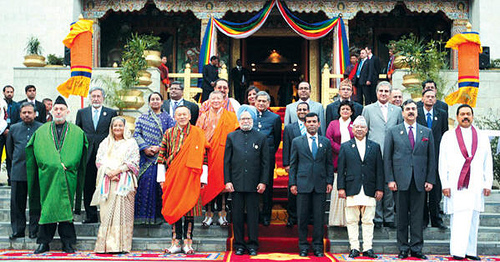Somewhat surprisingly, however, its third point ‘emphasised the need to develop a “Vision Statement” ’, something that should have been done a long time ago. Furthermore, SAARC has held only sixteen summits in 25 years, despite its Charter stating that ‘The Heads of State or Government shall meet once a year’. ‘Annual’ summits were not held in 1989, 1992, 1994, 1996, 1999, 2000, 2001, 2003, 2006 and 2009. More than one of these meetings was abandoned due to the parlous-to-poor state of India-Pakistan relations.
The India-Pakistan dynamic has long made South Asian regionalisation difficult. Neither nation trusts the other, while their invariable competition makes multilateral gatherings difficult. Despite bilateral and contentious issues being excluded from all SAARC deliberations, some SAARC leaders are now openly expressing frustration with strained India-Pakistan relations. Immediately before the recent SAARC summit, the Maldivian president, Mohamed Nasheed, stated that India and Pakistan need to engage in greater dialogue to resolve their differences. Bhutan’s prime minister, Jigme Thinley, while opening the summit, pointedly stated that ‘Fractious and quarrelsome neighbours do not make a prosperous community’.
Although such statements generally make little impression on entrenched India-Pakistan relations, the recent SAARC summit did achieve the so-called ‘Thimpu Thaw’. During the summit, prime ministers Singh and Gilani agreed that their foreign secretaries would get together to talk about having further India-Pakistan talks. This meeting will take place on 15 July. However, given the 18 months of non-contact between India and Pakistan since the Mumbai ‘26/11’ terrorist events, this is a miniscule melt, not a thaw.
A more international factor limits the greater regionalisation of South Asia: the West. The West does not really see South Asia as a whole. Indeed, in recent years, it increasingly, but not necessarily deliberately, has tended conveniently to split South Asia into two geo-strategic, economic regions: Western South Asia, comprising Afghanistan, Pakistan and India, and Eastern South Asia, comprising ‘the rest’: Bangladesh, Bhutan, the Maldives, Nepal and Sri Lanka.
The West is intensely focused on the important and topical ‘region’ of Western South Asia. This is mainly, but not exclusively, to do with the United States-led Global War on Terror (GWOT). The West wants the International Security Assistance Force (ISAF) to defeat the Taliban and/or al Qaeda in Afghanistan. As part of this greater ‘war’, it is seeking to develop a suitable government and defence forces in Afghanistan. Concurrently, it is providing arms, training and financial assistance to Pakistan to help it overcome its own internal terrorists, to remove terrorist safe havens along the ‘Af-Pak’ border, and to stem the flow of terrorists across this porous border.
The West also wants to reduce opium production in Afghanistan, partly to disrupt Taliban funding and partly to reduce the drug flows to potential Western consumers. It also is encouraging nuclear-armed India and Pakistan to maintain stable relations so that Pakistan can focus on defeating terrorists. There is a further—and important—factor for the West’s focus on Western South Asia: it wants to take advantage of India’s significant, and attractive, economic growth.
Conversely, the West is giving Eastern South Asia little attention. Bangladesh, Bhutan, the Maldives, Nepal and Sri Lanka offer little economically or strategically. Each is poor, with small economies and few significant exploitable resources. Strategically, they offer little—although this may change if China becomes more involved with these nations. And, with last year’s defeat of the Tamil Tigers and the ongoing integration of Maoist elements into mainstream Nepalese society, internal issues that may have demanded Western attention have diminished. Similarly, each nation of Eastern South Asia (and Afghanistan and Pakistan) is, to its credit, seeking to develop a multi-party, participatory democracy. So, apart from providing aid and economic assistance and dealing with some refugee issues, the West has, and will continue to have, little need to focus on Eastern South Asia.
After ISAF eventually leaves Afghanistan—and provided that the terrorists have been defeated there and in Pakistan—the most compelling reasons for the West to remain involved in South Asia will be India’s economic growth and its strategic intentions, particularly in relation to China. This will again weaken attempts to regionalise South Asia. Given that Indian territory separates all SAARC nations except for Afghanistan and Pakistan, India will also probably become the economic bridge that links this large, diverse and disparate ‘region’. Perhaps South Asia may then need to be re-named the ‘Indian subcontinental region’?
Christopher Snedden is Senior Lecturer and Director of the MA Program at the Centre for Defence and Strategic Studies, Deakin University.

